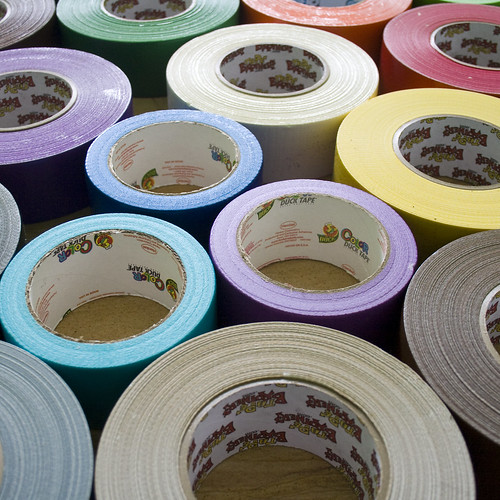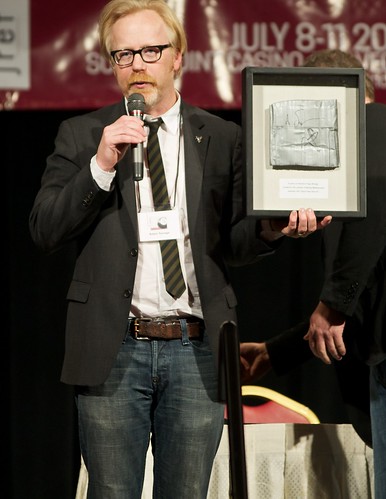 |
| woodleywonderworks' photosteam via flickr |
 |
| ktylerconk's photostream via flickr |
I also think of the vehicles I have seen driving down the road with duct tape covering a broken window, or holding a bumper on. I’m sure it doesn’t meet the automobile safety standards, but the duct tape does the job.
 |
| vasto's photosteam via flickr |
Once, when I was working at an assembly line job, an electrical fire broke out near my station. The mechanic came racing down to attend to the issue. He was searching for the tool necessary to fix the issue. I asked him why he didn’t have duct tape with him – I was under the impression any mechanic worth a lick would have that in his tool box. He just laughed...and pulled some out.
So, that leads me to presentation tools and multimedia tools for Web 2.0 – just give me the duct tape! I can do wonders with it. I have seen its value and know its versatility. I have clapped as principals were taped to gymnasium walls with duct tape(presentation for a charity fundraiser), Halloween costumes (did you know the Tin Man from the Wizard of Oz is the same tone of grey as duct tape?), science board presentations taped for added stability, and numerous other presentation variations of its use. And it is simple – cut off a piece and stick it on until you get the results you wanted.
 |
| DaveFayram's photostream via flickr |
Initially, this was not the case for Web 2.0 presentation and multimedia tools for me. I was stressed about the Web 2.0 adventure. It seems like the more I learn, the less I know. It takes time to learn all these tools. Sometimes things go smoothly, and often (for me) they don’t. It is always easy in hindsight, but I am a stress eater and right now, my hind is a sight!
 |
| mattbuck4950's photosteam via flickr |
My journey began with what I knew about Web 2.0 presentation and multimedia tools: very little beyond PowerPoint. I have seen a Prezi. I have attempted one Glogster, but I’m sure I didn’t do it properly and was left with a very basic poster. I have heard of Google Earth, but unfortunately the professional development I am registered for doesn’t start until November 17th.
When I looked at the list of what I needed to look at for this next post, I was overwhelmed. Here is what is suggested;
· Animoto
· Prezi
· Vuvox
· Jing
· Glogster
· Zoho
· Openzine
· Toondo
· Flipbook
I explored Animoto, VoiceThrea, Prezi and Google Earth a little more thoroughly, so the information regarding these tools are in separate posts. However, I dabbled briefly in a few others and some examples of my efforts are below.
Xtranormal: I played with Xtranormal briefly last night. It is very cool. I just wish I could get this lady to rap like some of the showcased productions. Kids would love working with dialogue using this tool. I could share the presentation in a number of ways, but I chose to publish it to YouTube. I can't wait to show my own kids, because I think this may be one of the things they want to play with online. As a note, there did seem to be some settings I wasn't sure about - maybe not "G" rated - something I would have to dig into further before I gave the go-ahead to students and my children.
http://www.vuvox.com/presentations/0311247f65
I also came across a few other suggestions in the Edutopia's Back to School Guide: Jump Start Learning with New Media, which you can download for free from http://www.edutopia.org/back-to-school-classroom-resource-guide.
Xtranormal: I played with Xtranormal briefly last night. It is very cool. I just wish I could get this lady to rap like some of the showcased productions. Kids would love working with dialogue using this tool. I could share the presentation in a number of ways, but I chose to publish it to YouTube. I can't wait to show my own kids, because I think this may be one of the things they want to play with online. As a note, there did seem to be some settings I wasn't sure about - maybe not "G" rated - something I would have to dig into further before I gave the go-ahead to students and my children.
Vuvox: I have played with this a little. Finally got the music to load. I will have to play with it more to get it to my liking, but here is my first attempt.
http://www.vuvox.com/presentations/0311247f65
I also came across a few other suggestions in the Edutopia's Back to School Guide: Jump Start Learning with New Media, which you can download for free from http://www.edutopia.org/back-to-school-classroom-resource-guide.
It contains great suggestions for setting up your digital classroom. I explored a number of them and have included a few quick examples, and a quick overview of a few of them here. These are a few of the more interesting presentation and multimedia tools:
Invitation Template:
Hi Guys n Gals
I have created a Wallwisher wall. It is a simple webpage where we all can post our messages easily.
So simply go to http://www.wallwisher.com/wall/kscheidy and post your message there.
Happy Posting!
kscheidy
This is such a neat tool. I can add sticky notes in the form of audio, text or an image. If you go to the wishwall I created you can already see links I have found for using the wishwall, links other people provided to Web 2.0 tools and manuals. As indicated above, I can invite people to my wishwall and they can add to it. I have the ability to moderate each post before it is posted to the wishwall. I think this is a great organizational tool for personal and professional use. Further, it is a great collaborative tool.
AnswerGarden is very simple tool to use for collaborative brainstorming. It is a tool that can be used to determine what students already know before proceeding with a lesson. It is a tool I can use on my blog to question people as they visit my site. I created one and added it to my blog on the sidebar. Try it out so I can see how it works! Users can also have all the responses compiled into a Wordle, which is another favorite tool of mine.
Another tool similar to wordle is Tagxedo. Check out the site 101 Ways to Use Tagxedo by Hardy Leung for an indepth look at the versatility of this tool. This is a Tagxedo made from my blog - I simply inserted my URL address, chose the layout and font, and the result was this:
Another tool which is so fun and students would love when creating diagrams for presenting materials is SimpleDiagrams. This video, How I'm Using "Simple Diagrams" with Coaching Clients by mavenaire demonstrates the ease of use and the effectiveness of this tool for communicating ideas.
This is an example of a SimpleDiagram I created:
Also worth checking out is Museum Box. With this site you can create your own artifacts museum to display items. You can include various forms of media in the boxes. These boxes allow to you put artifacts or items to create various perspectives of an issue, event, person, or any other topic you wanted to create a case for.
Of course, I only needed to explore several of these, not all of them. I used duct tape to hold my eyes open as I pulled more all-nighters in my attempt to learn to navigate the rugged wilderness of the Web 2.0 presentation and multimedia tools. The exploration posts for this week are titled:
Of course, I only needed to explore several of these, not all of them. I used duct tape to hold my eyes open as I pulled more all-nighters in my attempt to learn to navigate the rugged wilderness of the Web 2.0 presentation and multimedia tools. The exploration posts for this week are titled:
- A Gentle Stream – Animoto
- A Beautiful Sunrise - PowerPoint or Prezi, What's the Difference? - Prezi
- A Breath of Fresh Wilderness Air - VoiceThread
- Get Me Out of Here - Google Earth
- Xtranormal
These tools are definitely fun when everything is working well. I know my kids will enjoy playing with these tools at home - as an online toy and for entertainment. However, as a parent and a teacher, I see benefits in these tools which are limited to neither school nor home. I am better preparing my children for the Web 2.0 world if I am introducing them to these tools for personal and professional use (professional in their case is school).
Cheryl Lemke, president and CEO of Metiri Group (consulting firm advocating for the advanced use of technology in schools), writes about the implications for education due to the way we learn (new research is available due to new functional magnetic resonance imaging (fMRI). A very simplified summary of her research is that our working memory processes visuals differently than text and sound, similar to two different channels. Additionally, our working memory has very limited capacity for both. This affects the way educators teach on many levels. Lemke cites work by Mayer & Moreno (2003) which indicates that "people learn better from combining visuals with text and sound than through using either process alone, provided the design of learning resources follows certain multimedia principles" (Bellanca & Brandt, p. 248). Lemke then introduces the seven principles related to multimedia and modality:
This set of seven principles related to multimedia and modality is based on the work of Richard Mayer, Roxanne Moreno, and other prominent researchers (Chan &Black, 2006; Ginns, 2005; Mayer, 2001; Mayer & Morena, 2003).
1. Multimedia Principle: Student retention is improved through a combination of words (verbal or text) and visuals, rather than through words alone, provided it doesn't introduce redundancy of content.
2. Spatial Contiguity Principle: Students learn better when corresponding text and visuals are physically integrated rather than separated.
3. Temporal Contiguity Principle: Students learn better when corresponding text and visuals are temporally synchronized rather than separated in time.
4. Split-Attention Principle: Students learn better when extraneous words, pictures, and sounds are excluded rather than included.
5. Modality Principle: Students learn better when text is presented auditorily as speech rather than as on-screen text.
6. Individual Differences Principle: Design effects from these principles are higher for low-knowledge learners than for high-knowledge learners, and they are higher for high-spatial learners than for low-spatial learners.
7. Direct Manipulation Principle: As the complexity of the materials increases the impact of direct manipulation of the learning materials (animation, pacing) on transfer also increases.
Students engaged in learning that incorporates high-quality multimodal designs outperform, on average, students who learn using traditional approaches with single modes. This was borne out by a recent meta-analysis that revealed multimodality (the use of text or sound and visuals together) can positively shift achievement - provided the multimedia principles are followed. (Bellanca & Brandt, pp. 248-249)Lemke further states that the meta-analysis also indicated that non-interactive multimodal presentations resulted in a 21 percentile increase for those originally performing at the 50th percentile, and interactive presentations resulted in a 32 percentile increase. (Bellanca & Brandt, p. 249)
These are interesting findings. The principles are very similar to the requirements Bernajean Porter has for her Digital Storytelling - Digitales workshop. But on a larger note, does it really matter? Because, Lemke states, the Internet is here to stay - it is a place for recreation, communicating and leaning (Bellanca & Brandt, p. 243). Therefore, presentation and multimedia tools will be sticking around - without the duct tape!
Resources
21st century skills: Rethinking how students learn. Bloomington, IN: Solution Tree.
Bellanca, J., & Brandt, R. (2010).


No comments:
Post a Comment